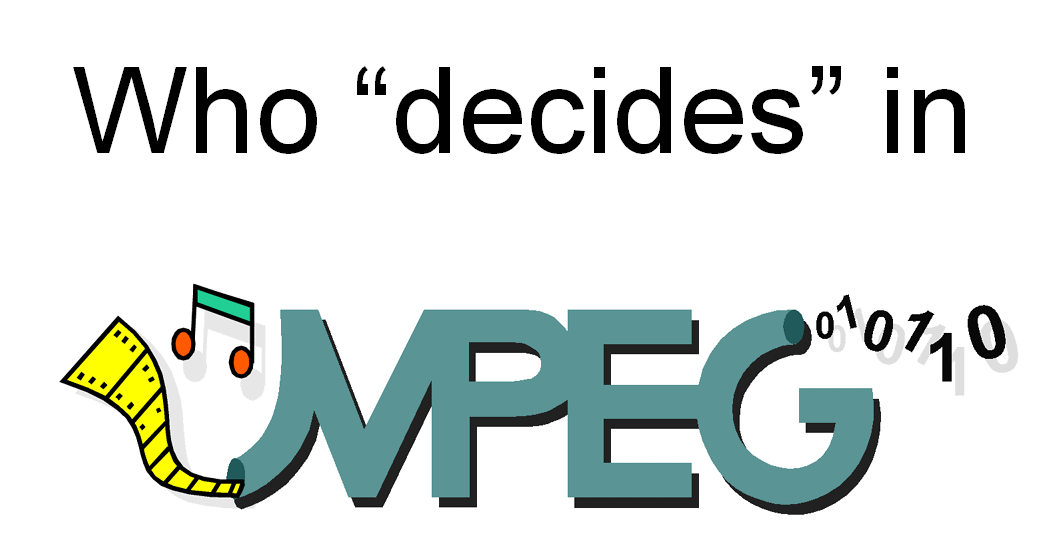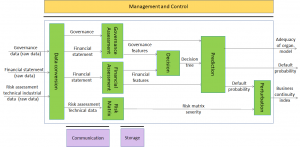If MPEG were a typical company, the answer to this question would be simple. Persons in charge of different levels of the organisation “decide”. But MPEG is not a company and there is no chain of command where A tells B to do C or else.
Decisions are made, but how? As an autocracy, an oligarchy or a democracy? To answer these questions, let’s first see how the work in MPEG is organised.
The convenor chairs the 3 plenary sessions.
- Monday morning: the results of the ad hoc groups established at the meeting before are presented and the work of the week is organised. The meeting last typically 3 hours. Typically no “decisions” are made.
- Wednesday morning: the results of the first two days of work are presented and the work of the rest of the week is organised. Comments and questions for clarification may be asked. Typically the meeting schedule for the next two years is approved, based on the recommendation of a group called “Convenor’s Advisors” who assesses proposals for meeting venues. This can hardly be called a “decision”. The meeting typically lasts 2 hours.
- Friday afternoon: the recommendations from subgroups are reviewed by the plenary. Typically they are read, possibly edited and, as a rule, accepted, unless there is a exception I will talk about later. One can say that the plenary “decides”, but actually it ratifies. The meeting typically last 4 hours.
So, where are decisions made?
To answer this question let’s see how the technical work is done in the subgroups: Requirements, Systems, Video (including groups in collaboration with ITU-T), Audio, 3D Graphics and Tests. This is the rough assignment of responsibilities:
- Requirements receives proposals for new work, manages the explorations that lead to issuing Calls for Proposals, participates in the assessment of test results and eventually in the definition of profiles. Requirements makes decisions.
- Technology development groups – Systems, Video, groups in collaboration with ITU-T, Audio and 3D Graphics – take the results of the test, develop draft specifications and manage the standard approval process (note that tests are not always required to start a new project, but a requirements definition phase is always present). Technology development groups make decisions.
- Tests carries out the growing number of tests that are required for the development of visual standards. Tests does not make decisions, it simply provides the results of test to the appropriate group.
It is clear that decisions are really made by subgroups, but how?
The main ingredients of decisions by technology development groups are input contributions by members and their assessment made by the specific subgroup. Evidence must be brought that a technology does what the proponents claims it does and the main tool to achieve this is called “Core Experiment”. This is carried out by the proponent and at least another independent participant.. The results from the two must be compatible and prove that the technology brings gains to be accepted into the standard.
The decisions of the technology development groups are not easy, but getting to a decision can be achieved in a structured way because technology plays an overriding role. Definitely less structured is the process managed by the Requirements group, done just by itself or jointly with a technical group. The decisions to be made are of the type: “does this proposal for new work make sense” or “is this profile needed”?
The question “does this proposal make sense” leaves ample margins for decision because a new technology may be in competition with another existing technology, can be immature, addresses a questionable need etc. MPEG tends to be open to new proposals based on the principle that if someone needs something, why should those unconcerned prohibit the work? After all, the task of MPEG is not to make a “decision” for the new work to start, but only to make a preliminary assessment of a proposal so that a formal proposal for a new work item can be made and voted by National Bodies.
So far, all MPEG proposals for new standards have passed the ISO acceptance criterion of simple majority of P members in the committee approving the proposal.
Adoption of a profile can also be a really tricky matter. Profiles are levels of performance, typically enabled by the presence of technologies in the profiles, required by certain application domains. How much is the profile driven by technology and how much by the market? Discussions may drag on for a long time but eventually a decision must be made. This one is a real decision because the profile becomes part of the standard.
In ISO, to which MPEG belongs, decision must be made by consensus. The ISO definition of consensus is
General agreement, characterized by the absence of sustained opposition to substantial issues by any important part of the concerned interests and by a process that involves seeking to take into account the views of all parties concerned and to reconcile any conflicting arguments.
NOTE Consensus need not imply unanimity.
Therefore MPEG subgroups make decisions based on this definition of consensus.
What about the exception made at plenaries I was talking about before? It may happen – and probably it did happen less that 10 times in the 30 years of MPEG history – that the party whose wish was overruled by a decision made by a subgroup based on the above definition of consensus, challenges the subgroup consensus at the Friday plenary. The plenary applies the definition of consensus in a very conservatory way to determine if the challenge has to be accepted or the subgroup decision is confirmed.
We can now see that the question “is MPEG an autocracy, an oligarchy or a democracy?” is the wrong question. The right one is the title of this article “who decides in MPEG”. The answer is: MPEG members, if they want to decide. If not the chairs or the convenor have the task of finding a way to a consensus or else declare that no consensus was found. Then, no decision is made.
Posts in this thread
- Who “decides” in MPEG?
- What is the difference between an image and a video frame?
- MPEG and JPEG are grown up
- Standards and collaboration
- The talents, MPEG and the master
- Standards and business models
- On the convergence of Video and 3D Graphics
- Developing standards while preparing the future
- No one is perfect, but some are more accomplished than others
- Einige Gespenster gehen um in der Welt – die Gespenster der Zauberlehrlinge
- Does success breed success?
- Dot the i’s and cross the t’s
- The MPEG frontier
- Tranquil 7+ days of hard work
- Hamlet in Gothenburg: one or two ad hoc groups?
- The Mule, Foundation and MPEG
- Can we improve MPEG standards’ success rate?
- Which future for MPEG?
- Why MPEG is part of ISO/IEC
- The discontinuity of digital technologies
- The impact of MPEG standards
- Still more to say about MPEG standards
- The MPEG work plan (March 2019)
- MPEG and ISO
- Data compression in MPEG
- More video with more features
- Matching technology supply with demand
- What would MPEG be without Systems?
- MPEG: what it did, is doing, will do
- The MPEG drive to immersive visual experiences
- There is more to say about MPEG standards
- Moving intelligence around
- More standards – more successes – more failures
- Thirty years of audio coding and counting
- Is there a logic in MPEG standards?
- Forty years of video coding and counting
- The MPEG ecosystem
- Why is MPEG successful?
- MPEG can also be green
- The life of an MPEG standard
- Genome is digital, and can be compressed
- Compression standards and quality go hand in hand
- Digging deeper in the MPEG work
- MPEG communicates
- How does MPEG actually work?
- Life inside MPEG
- Data Compression Technologies – A FAQ
- It worked twice and will work again
- Compression standards for the data industries
- 30 years of MPEG, and counting?
- The MPEG machine is ready to start (again)
- IP counting or revenue counting?
- Business model based ISO/IEC standards
- Can MPEG overcome its Video “crisis”?
- A crisis, the causes and a solution
- Compression – the technology for the digital age


